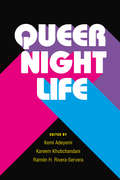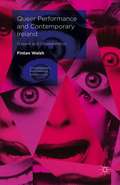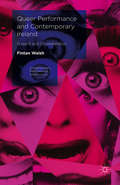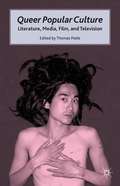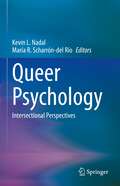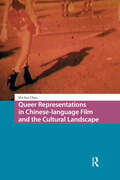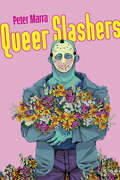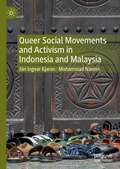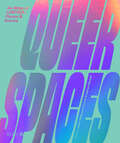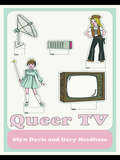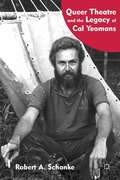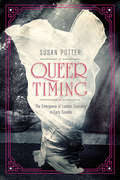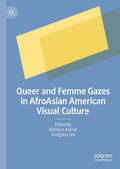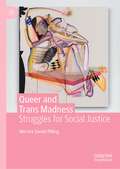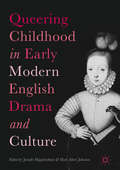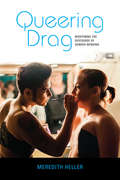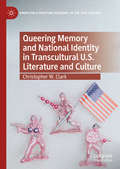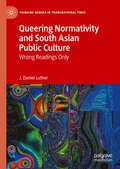- Table View
- List View
Queer Nightlife (Triangulations: Lesbian/Gay/Queer Theater/Drama/Performance)
by Ramon Rivera-Servera Kareem Khubchandani Kemi AdeyemiThe mass shooting at a queer Latin Night in Orlando in July 2016 sparked a public conversation about access to pleasure and selfhood within conditions of colonization, violence, and negation. Queer Nightlife joins this conversation by centering queer and trans people of color who apprehend the risky medium of the night to explore, know, and stage their bodies, genders, and sexualities in the face of systemic and social negation. The book focuses on house parties, nightclubs, and bars that offer improvisatory conditions and possibilities for “stranger intimacies,” and that privilege music, dance, and sexual/gender expressions. Queer Nightlife extends the breadth of research on “everynight life” through twenty-five essays and interviews by leading scholars and artists. The book’s four sections move temporally from preparing for the night (how do DJs source their sounds, what does it take to travel there, who promotes nightlife, what do people wear?); to the socialities of nightclubs (how are social dance practices introduced and taught, how is the price for sex negotiated, what styles do people adopt to feel and present as desirable?); to the staging and spectacle of the night (how do drag artists confound and celebrate gender, how are spaces designed to create the sensation of spectacularity, whose bodies become a spectacle already?); and finally, how the night continues beyond the club and after sunrise (what kinds of intimacies and gestures remain, how do we go back to the club after Orlando?).
Queer Performance and Contemporary Ireland: Dissent and Disorientation (Contemporary Performance InterActions)
by Fintan WalshThis book examines the surge of queer performance produced across Ireland since the first stirrings of the Celtic Tiger in the mid-1990s, up to the passing of the Marriage Equality referendum in the Republic in 2015.
Queer Performance and Contemporary Ireland: Dissent and Disorientation (Contemporary Performance InterActions)
by Fintan WalshThis book examines the surge of queer performance produced across Ireland since the first stirrings of the Celtic Tiger in the mid-1990s, up to the passing of the Marriage Equality referendum in the Republic in 2015.
Queer Popular Culture: Literature, Media, Film, and Television
by Thomas PeeleThis collection addresses the politics of queer representation in multiple contexts. Articles cover the rise of the queer cowboy, the emergence of lesbian chic, and the expansion of representations of blackness alongside work on queer, Taiwanese, online communities; a transgender Israeli pop star; and film mimicry in Kerala, India.
Queer Psychology: Intersectional Perspectives
by Kevin L. Nadal María R. Scharrón-del RíoQueer Psychology is the first comprehensive book to examine the current state of LGBTQ communities and psychology, through the lenses of both queer theory and Intersectionality theory. Thus, the book describes the experiences of LGBTQ people broadly, while also highlighting the voices of LGBTQ people of color, transgender and gender nonconforming people, those of religious minority groups, immigrants, people with disabilities, and other historically marginalized groups. Each chapter will include an intersectional case example, as well as implications for policy and practice.This book is especially important as there has been an increase in psychology and counseling courses focusing on LGBTQ communities; however, students often learn about LGBTQ-related issues through a White cisgender male normative perspective. The edited volume contains the contributions of leading scholars in LGBTQ psychology, and covers a number of concepts – ranging from identity development to discrimination to health.
Queer Representations in Chinese-language Film and the Cultural Landscape (Asian Visual Cultures)
by Shi-Yan ChaoQueer Representations in Chinese-language Film and the Cultural Landscape provides a cultural history of queer representations in Chinese-language film and media, negotiated by locally produced knowledge, local cultural agency, and lived histories. Incorporating a wide range of materials in both English and Chinese, this interdisciplinary project investigates the processes through which Chinese tongzhi/queer imaginaries are articulated, focusing on four main themes: the Chinese familial system, Chinese opera, camp aesthetic, and documentary impulse. Chao’s discursive analysis is rooted in and advances genealogical inquiries: a non-essentialist intervention into the Chinese idea of filial piety, a transcultural perspective on the contested genre of film melodrama, a historical investigation of the local articulations of mass camp and gay camp, and a transnational inquiry into the different formats of documentary. This book is a must for anyone exploring the cultural history of Chinese tongzhi/queer through the lens of transcultural media.
Queer Slashers (Icons of Horror)
by Peter MarraFrom Norman Bates dressed as "Mother" in Psycho to the rouged cheeks of Leatherface in The Texas Chainsaw Massacre, many slasher icons have borne traces of queer and gender nonconforming behavior since the subgenre's very beginning.Queer Slashers presents the first book-length study of how and why the slasher subgenre of horror films appeals to queer audiences. In it, Peter Marra constructs a reparative history of the slasher that affirms its queer lineage extending back as early as the 1920s. It also articulates the queer aspects of the slasher formula that forge an unlikely kinship between queer audiences and these retrograde depictions of queer killers. Marra establishes a queer history and function for the slasher, analyzing several key contemporary "queer slashers"–that is, slashers that are made by queer filmmakers–to better understand how queer artists take up the slasher iconography and put it toward modern queer aims.Featuring analysis of films such as John Waters's Serial Mom, Peaches Christ's All About Evil, and Alain Guiraudie's Stranger by the Lake, Queer Slashers illuminates the queer meanings of slashers, their foundations, and their future possibilities.
Queer Social Movements and Activism in Indonesia and Malaysia
by Jón Ingvar Kjaran Mohammad NaeimiThis book examines queer activism and queer social movements (QSMs) in Indonesia and Malaysia, broadly engaging with these topics on three different levels: macro (global and national discourses), meso (organizational level – activities), and micro (individual – the activist). The micro level perspective allows for moving beyond the “traditional” political movement paradigm by understanding activism in Foucauldian terms as the ethics of the self (Foucault, 1984). In other words, the queer subject is seen as an active agent in taking care of the self by queering/resisting gender norms as well as heteronormative practices and regimes in their social environment through embodiment and actions. This kind of ethical being has the potential to build support and community between and amongst individuals.
Queer Spaces: An Atlas of LGBTQ+ Places and Stories
by Adam Nathaniel Furman Joshua MardellAn independent bookshop in Glasgow. An ice cream parlour in Havana, where strawberry is the queerest choice. A cathedral in ruins in Managua, occupied by the underground LGBTQIA+ community. Queer people have always found ways to exist and be together, and there will always be a need for queer spaces. In this lavishly illustrated volume, Adam Nathaniel Furman and Joshua Mardell have gathered together a community of contributors to share stories of spaces that range from the educational to the institutional to the re-appropriated, and many more besides. With historic, contemporary and speculative examples from around the world, Queer Spaces recognises LGBTQIA+ life past and present as strong, vibrant, vigorous, and worthy of its own place in history. Looking forward, it suggests visions of what form these spaces may take in the future to continue uplifting queer lives. Featured spaces include: Black Lesbian and Gay Centre, London Category Is Books, Glasgow Christopher Street, New York Coppelia, Havana New Sazae, Tokyo ONE Institute for Homophile Studies, Los Angeles Pop-Up spaces, Dhaka Queer House Party, Online Santiago Apóstol Cathedral, Managua Trans Memory Archive, Buenos Aires Victorian Pride Centre, Melbourne
Queer TV: Theories, Histories, Politics
by Glyn Davis Gary NeedhamHow can we queerly theorise and understand television? How can the realms of television studies and queer theory be brought together, in a manner beneficial and productive for both? Queer TV: Theories, Histories, Politics is the first book to explore television in all its scope and complexity – its industry, production, texts, audiences, pleasures and politics – in relation to queerness. With contributions from distinguished authors working in film/television studies and the study of gender/sexuality, it offers a unique contribution to both disciplines. An introductory chapter by the editors charts the key debates and issues addressed within the book, followed by three sections, each central to an understanding of the relationships between queerness and television: 'theories and approaches', histories and genres', and 'television itself'. Individual essays examine the relationships between queers, queerness, and television across the multiple sites of production, consumption, reception, interpretation and theorisation, as well as the textual and aesthetic dimensions of television and the televisual. The book crucially moves beyond lesbian and gay textual analyses of specific TV shows that have often focussed on evaluations of positive/negative representations and identities. Rather, the essays in Queer TV theorise not just the queerness in/on television (the production personnel, the representations it offers) but also the queerness of television as a distinct medium.
Queer Theatre And The Legacy Of Cal Yeomans
by Robert A. SchankeA forgotten yet award-winning playwright, Cal Yeomans was one of the founders of gay theater whose work was fueled by gay liberation and extinguished by the AIDS epidemic. Schanke's examination of his life and legacy allows a rare exploration into this pivotal moment of gay American history.
Queer Timing: The Emergence of Lesbian Sexuality in Early Cinema (Women & Film History International)
by Susan PotterIn Queer Timing, Susan Potter offers a counter-history that reorients accepted views of lesbian representation and spectatorship in early cinema. Potter sees the emergence of lesbian figures as only the most visible but belated outcome of multiple sexuality effects. Early cinema reconfigured older erotic modalities, articulated new--though incoherent--sexual categories, and generated novel forms of queer feeling and affiliation. Potter draws on queer theory, silent film historiography, feminist film analysis, and archival research to provide an original and innovative analysis. Taking a conceptually oriented approach, she articulates the processes of filmic representation and spectatorship that reshaped, marginalized, or suppressed women's same-sex desires and identities. As she pursues a sense of "timing," Potter stages scenes of the erotic and intellectual encounters shared by historical spectators, on-screen figures, and present day scholars. The result is a daring revision of feminist and queer perspectives that foregrounds the centrality of women's same-sex desire to cinematic discourses of both homo- and heterosexuality.
Queer and Femme Gazes in AfroAsian American Visual Culture
by Rebecca Kumar Seulghee LeeQueer and Femme Gazes in AfroAsian American Visual Culture is a scholarly collection that takes comparative Black-Asian representations in televisual culture from queer and femme perspectives. AfroAsian representations on screen—as well as their attendant critical gazes—have historically emphasized cross-racial masculinities at the expense of queer and/or femme visions. The prevalence of these previous televisual artefacts—and the ways they have been watched—has contributed directly to white heteronormative legacies within film and visual studies. The collection intervenes by excavating the intimacies and political possibilities within AfroAsian femme, queer, and transgender life. The authors offer alternative ways of looking at racial representation in their attendance to developments in AfroAsian visual culture: music videos, video games, genre serials, and independent and short films.
Queer and Trans Madness: Struggles for Social Justice
by Merrick Daniel PillingThis book urges those invested in social justice for 2SLGBTQ people to interrogate the biomedical model of mental illness beyond the diagnoses that specifically target gender and sexual dissidence. In this first comprehensive application of Mad Studies to queer and trans experiences of mental distress, Pilling advances a broad critique of the biomedical model of mental illness as it pertains to 2SLGBTQ people, arguing that Mad Studies is especially amenable to making sense of queer and trans madness. Based on empirical data from two qualitative research studies, this book includes analyses of inpatient chart documentation from a psychiatric hospital and interviews with those who have experienced distress. Using an intersectional lens, Pilling critically examines what constitutes mental health treatment and the impacts of medical strategies on mad queer and trans people. Ultimately, Queer and Trans Madness: Struggles for Social Justice explores the emancipatory promise of queer and trans madness, advocating for more resources to respond to crisis and distress in ways that are non-coercive, non-carceral, and honour autonomy as well as interdependence within 2SLGBTQ communities.
Queering Childhood in Early Modern English Drama and Culture
by Jennifer Higginbotham Mark Albert JohnstonThis volume analyzes early modern cultural representations of children and childhood through the literature and drama of Shakespeare and his contemporaries. Contributors include leading international scholars of the English Renaissance whose essays consider asexuals and sodomites, roaring girls and schoolboys, precocious princes and raucous tomboys, boy actors and female apprentices, while discussing a broad array of topics, from animal studies to performance theory, from queer time to queer fat, from teaching strategies to casting choices, and from metamorphic sex changes to rape and cannibalism. The collection interrogates the cultural and historical contingencies of childhood in an effort to expose, theorize, historicize, and explicate the spectacular queerness of early modern dramatic depictions of children.
Queering Drag: Redefining the Discourse of Gender-Bending
by Meredith HellerTheatrical gender-bending, also called drag, is a popular form of entertainment and a subject of scholarly study. However, most drag studies do not question the standard words and ideas used to convey this performance genre. Drawing on a rich body of archival and ethnographic research, Meredith Heller illuminates diverse examples of theatrical gender-bending: male impersonation in variety and vaudeville (1860–1920); the "sexless" gender-bending of El Teatro Campesino (1960–1980); queer butch acts performed by black nightclub singers, such as Stormé DeLarverie, instigator of the Stonewall riots (1910–1970); and the range of acts that compose contemporary drag king shows. Heller highlights how, in each case, standard drag discourses do not sufficiently capture the complexity of performers' intents and methods, nor do they provide a strong enough foundation for holistically evaluating the impact of this work. Queering Drag offers redefinition of the genre centralized in the performer's construction and presentation of a "queer" version of hegemonic identity, and it models a new set of tools for analyzing drag as a process of intents and methods enacted to effect specific goals. This new drag discourse not only allows for more complete and accurate descriptions of drag acts, but it also facilitates more ethical discussions about the bodies, identities, and products of drag performers.
Queering Memory and National Identity in Transcultural U.S. Literature and Culture (American Literature Readings in the 21st Century)
by Christopher W. ClarkThis book examines the queer implications of memory and nationhood in transcultural U.S. literature and culture. Through an analysis of art and photography responding to the U.S. domestic response to 9/11, Iraq war fiction, representations of Abu Ghraib and Guantánamo Bay, and migrant fiction in the twenty-first century, Christopher W. Clark creates a queer archive of transcultural U.S. texts as a way of destabilizing heteronormativity and thinking about productive spaces of queer world-building. Drawing on the fields of transcultural memory, queer studies, and transculturalism, this book raises important questions of queer bodies and subjecthood. Clark traces their legacies through texts by Sinan Antoon, Mohamedou Ould Slahi among others, alongside film and photography that includes artists such as Nina Berman and Hasan Elahi. In all, the book queers forms of cultural memory and national identity to uncover the traces of injury but also spaces of regeneration.
Queering Normativity and South Asian Public Culture: Wrong Readings Only (Thinking Gender in Transnational Times)
by J. Daniel LutherThis book develops a queer methodology to analyse a queer archive for the impact of normativity on subjecthood and the ways in which it shapes and curtails gender and sexuality. Chapters demonstrate how normativity functions to mask its own operation, is internalised by subjects, and is continually reproduced through discourse and in material ways. In seeking to make visible the functioning of normativity, the book performs a task of queering normativity by querying that which appears as natural in South Asian public culture. The book engages with both the consolidation and the unsettling of normativity through artefacts of South Asian public culture including canonical figures such as Rabindranath Tagore, literary and cinematic texts, Bollywood films, advertisements, social media posts, and ubiquitous ephemera in South Asia and beyond. Through these texts, the author unpacks the construct of canon, the nation, woman as a post-colonial subject, the home and the child, marriage, same-sex sexuality and identity.This book will be of interest to scholars and students studying and researching Queer Studies, Gender and Sexuality Studies, South Asian Studies, Cultural Studies, Literary Studies, Film Studies, and Media Studies.
Queering Polishness in Polish Theatre Since 2005: Dissenting Bodies
by Jonas VanderschuerenTheatre has long been an art form at the centre of public life in Poland. Whether it is the self-professed poet-prophets of the Romantic era, or the dissident theatre makers working under the strictures of state socialism, the art form has played a vital role in the development of Polish culture and politics in the context of shifting foreign occupations. This book explores the relationship between contemporary Polish theatre makers and contemporary notions of Polishness and argues that queer theory, and specifically a Polish appropriation of queer theory, can be a crucial element to better understand the politicality of the contemporary Polish theatre field. It does this by focusing on critical theatre productions which are produced at the margins of the Polish theatre field, a choice which has been made as the field is dominated by traditional drama theatres which reproduce a Polish variation on the Western canon. This makes smaller, atypical, and independent theatre productions all the more significant, as they signify a refusal to continue the traditional role of the Polish theatre field in reproducing the canon of Polish Romanticism. As such, the book argues that contemporary Polish theatre has been marked by a struggle between those building performances and state authorities that see those creations as a threat to their authority.
Queering Teen Culture: All-American Boys and Same-Sex Desire in Film and Television
by Jeffery P DennisWhy did Fonzie hang around with all those high school boys?Is the overwhelming boy-meets-girl content of popular teen movies, music, books, and TV just a cover for an undercurrent of same-sex desire? From the 1950s to the present, popular culture has involved teenage boys falling for, longing over, dreaming about, singing to, and fighting over, teenage girls. But Queering Teen Culture analyzes more than 200 movies and TV shows to uncover who Frankie Avalon&’s character was really in love with in those beach movies and why Leif Garrett became a teen idol in the 1970s. In Top 40 songs, teen magazines, movies, TV soap operas and sitcoms, teenagers are defined by their pubescent "discovery" of the opposite sex, universally and without exception. Queering Teen Culture looks beyond the litany to find out when adults became so insistent about teenage sexual desire-and why-and finds evidence of same-sex desire, romantic interactions, and identities that, according to the dominant ideology, do not and cannot exist. This provocative book examines the careers of male performers whose teenage roles made them famous (including Ricky Nelson, Pat Boone, Fabian, and James Darren) and discusses examples of lesbian desire (including I Love Lucy and Laverne and Shirley). Queering Teen Culture examines: Ozzie and Harriet, Father Knows Best, and Leave It to Beaver: Were Ricky, Bud, and Wally sufficiently straight? the juvenile delinquent films of the 1950s: Why weren&’t the rebel-without-a-cause "bad boys" interested in girls? horror, sci-fi, and zombies from outer space: "Body of a boy! Mind of a monster! Soul of an unearthly thing!" teen idols-pretty, androgynous, and feminine: No wonder they were rumored to be "funny" beach movies: She wants to plan their wedding but he wants to surf, sky-dive and go drag racing with the guys Biker-hippies boys of the late 1960s: "I know your scene-don&’t think I don&’t!" the 1950s nostalgia of the 1970s: Why does Fonzie spend all his time with high school boys? teen gore: What makes the psycho-killer angry? and much more, including Gidget, the Brat Pack, buddy dramas, nerds and "operators," Saved by the Bell, The Real World, and the incredible shrinking teenager Queering Teen Culture is an essential read for academics working in cultural and gay studies, and for anyone else with an interest in popular culture.
Queering Teen Culture: All-American Boys and Same-Sex Desire in Film and Television
by Jeffrey P. DennisExamines text and subtext in relationships between male characters in t.v. and film from the 1950s through the present.
Queering Tribal Folktales from East and Northeast India
by Kaustav ChakrabortyThis book explores queer potentialities in the tribal folktales of India. It elucidates the queer elements in the oral narratives of four indigenous communities from East and Northeast India, which are found to be significant repositories of gender fluidity and non-normative desires. Departing from the popular understanding that ‘Otherness’ results largely from undue exposure to Western permissiveness, the author reveals how minority sexualities actually have their roots in aboriginal indigenous cultures and do not necessarily constitute a mimicry of the West. The volume endeavours to demystify the politics behind such vindictive propagation to sensitize the queerphobic mainstream about the essential endogenous presence of the queer in the spaces that are aboriginal. Based on extensive interdisciplinary research, this book is a first of its kind in the study of indigenous queer narratives. It will be useful to scholars and researchers of queer studies, gender studies, tribal and indigenous studies, literature, cultural studies, postcolonialism, sociology, political studies and South Asian studies.
Queering Urbanism: Insurgent Spaces in the Fight for Justice
by Stathis G. YerosA free ebook version of this title is available through Luminos, University of California Press’s Open Access publishing program. Visit www.luminosoa.org to learn more. Conflicts about space and access to resources have shaped queer histories from at least 1965 to the present. As spaces associated with middle-class homosexuality enter mainstream urbanity in the United States, cultural assimilation increasingly erases insurgent aspects of these social movements. This gentrification itself leads to queer displacement. Combining urban history, architectural critique, and queer and trans theories, Queering Urbanism traces these phenomena through the history of a network of sites in the San Francisco Bay Area. Within that urban landscape, Stathis Yeros investigates how queer people appropriated existing spaces, how they expressed their distinct identities through aesthetic forms, and why they mobilized the language of citizenship to shape place and secure space. Here the legacies of LGBTQ+ rights activism meet contemporary debates about the right to housing and urban life.
Queering W. B. Yeats and Gabriele D’Annunzio: Modernist Playwrights (New Directions in Irish and Irish American Literature)
by Zsuzsanna BalázsQueering W. B. Yeats and Gabriele D’Annunzio: Modernist Playwrights challenges the general resistance in scholarship and queer studies to approach Yeats and D’Annunzio through a queer lens because of their controversial affiliations with fascism and elitism, their heterosexuality and their venerated canonical status. This book provides the first fully theorised queer and comparative reading of Yeats’s and D’Annunzio’s drama. It offers the novel contention that due to their increasing involvement in queer and feminist subcultures, their plays feature feelings that are associated with queer historiography and generate ideas that began to be theorised by queer studies more than half a century after the composition of the plays. Moreover, it uncovers an alert, subversive and often coded social commentary in eight key dramatic texts by each playwright and at the same time highlights the thus far neglected commonalities between the plays and the queer historical as well as cultural contexts of these two prominent modernists.
Queering the Family in The Walking Dead
by John R. ZieglerThis book traces how The Walking Dead franchise narratively, visually, and rhetorically represents transgressions against heteronormativity and the nuclear family. The introduction argues that The Walking Dead reflects cultural anxiety over threats to the family. Chapter 1 examines the destructive competition created by heteronormativity, such as the conflict between Rick and Shane. Chapter 2 focuses on the actual or attempted participation of characters such as Carol and Negan in queer relationships. Chapter 3 interprets zombies as queer antagonists to heteronormativity, while Chapter 4 explores the incorporation of zombies into the lives of characters such as the Governor and the Whisperers. The conclusion asserts that The Walking Dead presents both queer alternatives to and damaging contradictions within the traditional heterosexual family model, helping to question this model and to consider the struggle of queer American families. Overall, this study holds special interest for students and scholars of queerness, zombies, and the family.
